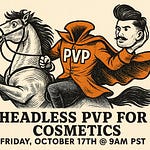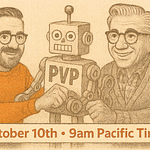So I cheated last Friday.
Not my proudest moment, but I’m flying over the Atlantic at 2 AM thinking about our Halloween cage match with Jordan, and I realize: there’s no way I’m winning this thing playing fair. Jordan’s going to do the Jordan thing—spin up some brilliant bottom-up PVP out of thin air while I’m still segmenting markets like it’s 2019.
So I decide to cheat. I’m going to assume we have first-party data.
Turns out, that “cheat” led us to the most important insight we haven’t been talking about enough: the absolute gold standard of PVP creation isn’t about better prompts or smarter AI—it’s about having data no one else can access.
What Actually Happened
We were building PVPs for Kimoby, a Dealership Engagement System for auto dealers. Jordan goes bottom-up, starts with a killer insight about service advisors struggling with approval rates. Classic Jordan. Beautiful. Actionable.
I go top-down, running through segmentation, ICP analysis, the whole methodology. And then I pivot: “What if Kimoby already knows which dealerships struggle with customer pay revenue? What if they have approval rate data, service department efficiency metrics, which communication patterns drive RO increases?”
Jordan stops. “Yeah, that’s the absolute gold standard. Network effects make it impossible for anyone to compete.”
I still lost the cage match (Vegas had me at 6:1 odds for a reason), but we stumbled into something we don’t talk about nearly enough.
The First-Party Data Moat
Here’s what makes first-party data PVPs unbeatable:
1. No One Else Can Say It
When Housecall Pro looks at a home’s service history and says, “Hey, you just had foundation work done and new landscaping installed, you probably need a termite inspection within the next 60 days,” that’s not publicly available information.
That’s aggregated intelligence from thousands of homes showing: foundation work + new landscaping = termite risk. Only Housecall Pro can make that connection. Only they have the data.
2. It Gets Smarter Over Time
Public data is static. First-party data compounds. Every customer interaction improves the signal. Every transaction refines the pattern. Every outcome validates (or invalidates) the hypothesis.
Your PVPs don’t just work, they get better. Automatically. That’s a moat that widens over time.
3. It’s Actually Permissionless
The best first-party PVPs don’t feel like marketing. They feel like value delivery:
“Based on similar restaurants in your market, you’re leaving $47K annually on the table by not optimizing your third-party delivery mix”
“Law firms using your practice management software that implemented these three workflows saw 23% faster collections”
“Your current equipment utilization rate of 62% puts you in the bottom quartile—here’s what the top performers are doing differently”
You’re not asking for a meeting. You’re delivering intelligence they can’t get anywhere else.
The Kimoby Example (If They Had The Data)
Here’s what I was building toward before Jordan crushed me:
Imagine Kimoby’s data shows that dealerships with service advisors who send personalized video estimates have 43% higher approval rates, but only when sent within 90 minutes of vehicle check-in. And they can identify which dealerships are missing this window based on their timestamp data and approval patterns.
The PVP writes itself:
“Your service advisors are averaging 3.2 hours between vehicle check-in and estimate delivery. Dealerships in your metro that cut this to under 90 minutes are seeing $127K more in monthly customer pay revenue. Here’s the exact workflow change that’s working for them.”
No competitor can offer that. No amount of prompt engineering gets you there. You need the data.
Why We Don’t Talk About This Enough
Honestly? Because most of our clients don’t think they have it.
We spend so much time teaching public data research, web scraping, creative data mining—all the ways to build PVPs when you’re starting from zero. And that’s valuable. Most companies are there.
But we’ve been leaving money on the table by not talking about what happens when you graduate from public data to proprietary intelligence.
The Framework: Finding Your First-Party Gold
If you’re sitting on customer data (and you probably are), here’s how to mine it for PVP creation:
Pattern Recognition Questions:
What do your best customers do that others don’t?
What early behaviors predict later success or failure?
What problems cluster together in ways customers don’t see?
What do customers wish they’d known six months ago?
Data You Already Have:
Usage patterns and feature adoption
Support ticket themes and timing
Completion rates and drop-off points
Time-to-value metrics by segment
Outcome data (what actually worked)
The Translation: Your internal data → Aggregated insight → Proactive value delivery → Permissionless outreach
The Competitive Reality
Every SaaS company is racing to become “AI-native.” Every GTM team is adopting the same tools, reading the same substacks, running the same plays.
First-party data is the only truly defensible advantage in this environment. It’s the only thing your competitors can’t copy, can’t automate, can’t prompt-engineer their way into.
We proved it on Friday. Even when I was “cheating,” even when I was assuming advantages I didn’t have, the first-party approach was so obviously superior that Jordan—who won the actual competition—immediately said: “Yeah, that’s the gold standard.”
What This Means For You
If you’re building PVPs from public data: keep going. That’s where everyone starts. The methodology works.
But if you’re sitting on customer data and you’re not mining it for PVP creation, you’re playing the wrong game. You’re competing on creativity and research when you could be competing on information asymmetry.
The best PVPs don’t just identify pain points. They predict them. They quantify them with precision your prospects didn’t know was possible. They deliver value that feels like magic because it’s based on patterns they can’t see.
That’s not something you can scrape from the web.
That’s network effects. That’s compounding advantage.
That’s what we should have been talking about all along.









